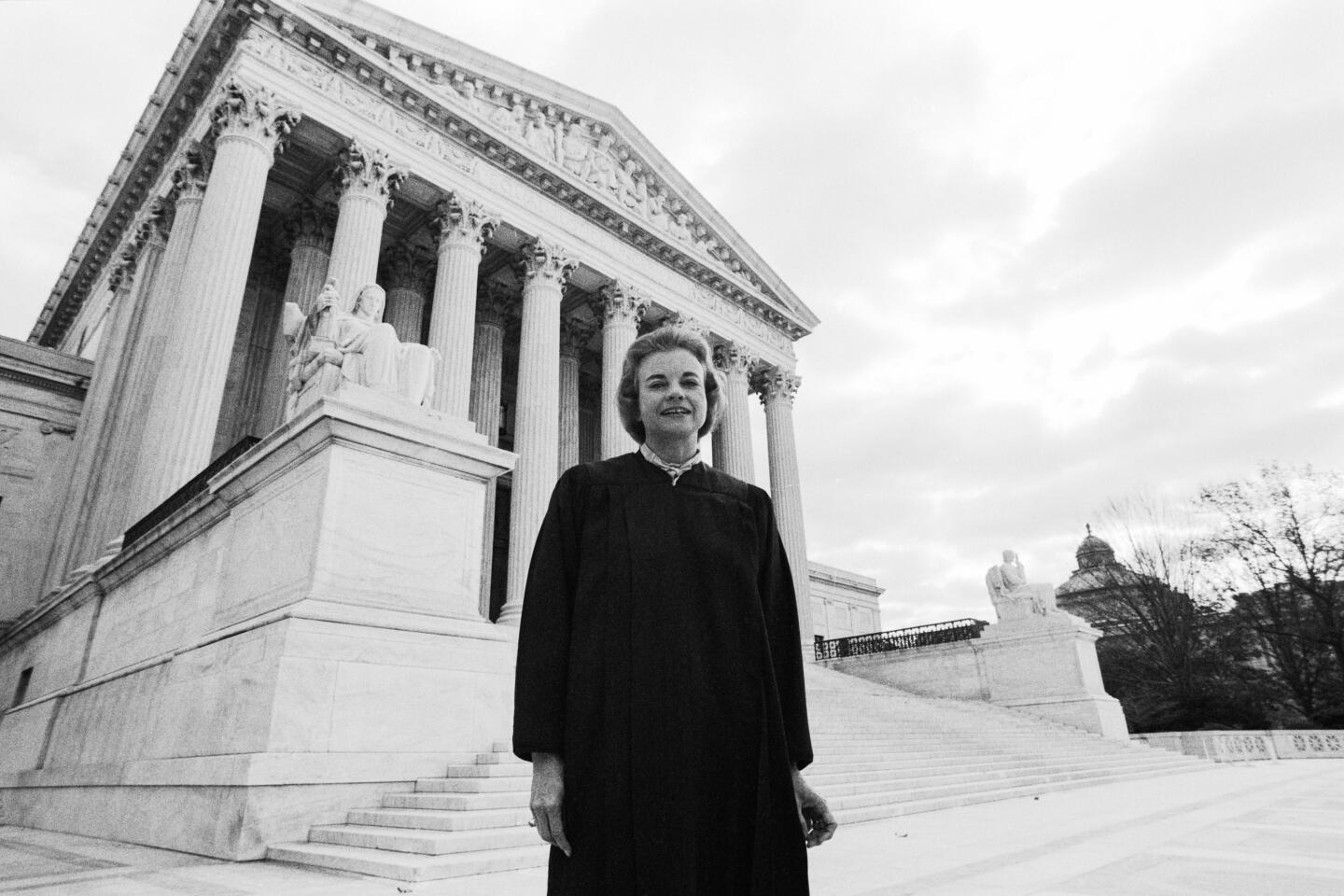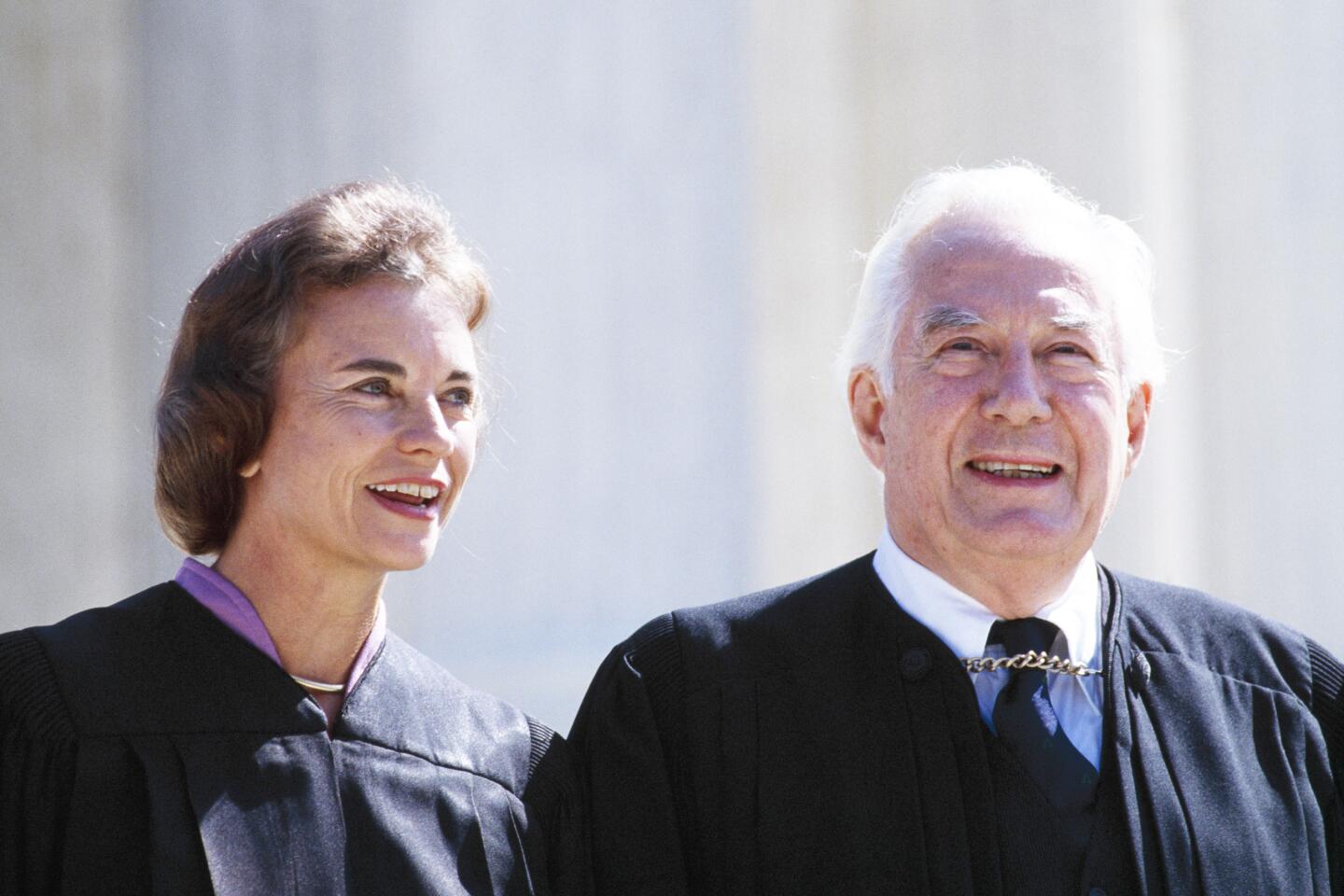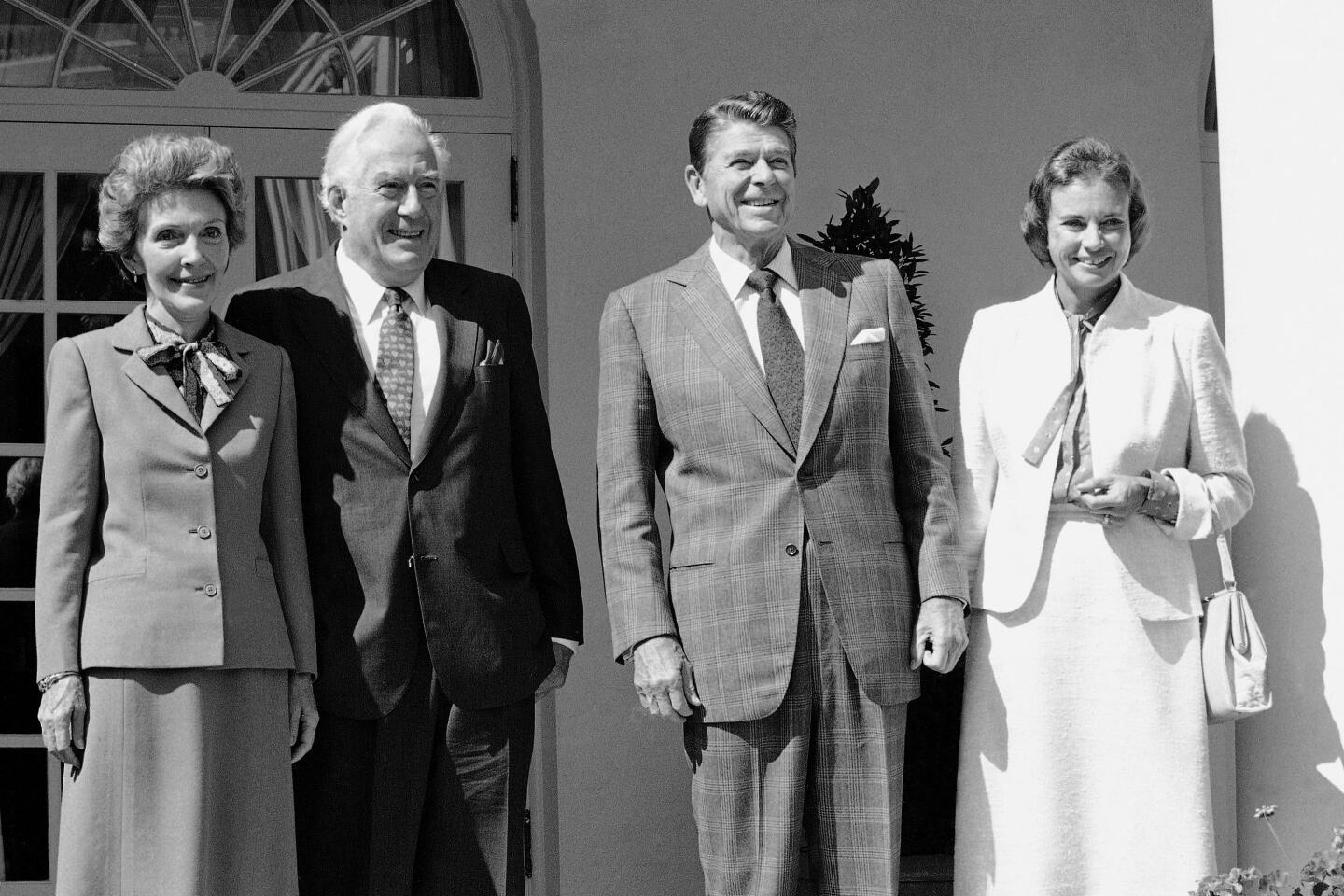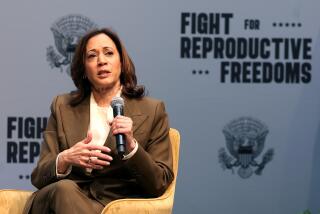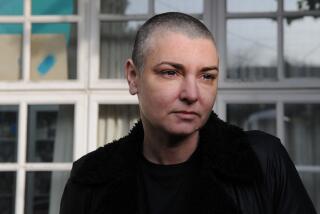Sandra Day O’Connor, first woman appointed to Supreme Court, dead at 93
- Share via
Retired Supreme Court Justice Sandra Day O’Connor, the first woman to ascend to the high court and its most influential jurist for much of her 24-year tenure, died Friday.
O’Connor announced in 2018 that she had been diagnosed with the early stages of dementia. She died Friday morning in Phoenix, the court announced. She was 93.
Before her retirement in 2006, O’Connor was often described as the most powerful woman in America as well as one of its most admired public officials. She was a centrist on an ideologically divided court, and she used her position to steer a middle course on the controversial issues of her time, including affirmative action, abortion, religion and the death penalty.
The daughter of an Arizona cattle rancher, she made history the day she arrived at the Supreme Court in 1981. The justices had long been known as “the brethren,” as the nine men who had the final word on the meaning of the U.S. Constitution.
President Reagan had made a campaign promise in 1980 to appoint a woman to the Supreme Court when the first vacancy arose. And the opportunity came sooner than he might have guessed: Four months after the Republican took office, Justice Potter Stewart passed on the word that he was planning to retire at the end of June.
In his place, Reagan chose a little-known Arizona state judge who had been championed by Sen. Barry Goldwater, the conservative stalwart whose 1964 campaign for president had brought Reagan into national politics.
O’Connor, then 51, had graduated near the top of her Stanford Law School class. Her instincts were those of a legislator, a job she held before becoming a judge. She’d been appointed to the Arizona state Senate in 1969 and won reelection twice as a Republican. In 1973, she was elected as the majority leader, becoming the first woman to hold the post in any state.
Her views on the great legal issues of the day were largely unknown when Reagan nominated her, although she assured him she found abortion personally “abhorrent.” She won a quick confirmation from the Senate.
::
Within a few years of her arrival, O’Connor moved into position as the decisive justice on many issues. She was frequently described as the “swing vote,” who could tip the outcome of a case in favor of either the conservative or the liberal faction of the bench. Her role went well beyond that, however.
After joining the high court in 1981, she used skills she’d honed as a legislator to focus on the narrow points that divided the two sides and seek a middle position. On the most divisive issues, O’Connor usually found a way to set out a ruling — sometimes by deciding only a narrow issue — that would win the support of a five-member majority.
A classic example came in 2003, when college affirmative-action plans were being challenged in the court. Over the previous 20 years, O’Connor had joined her more conservative colleagues in criticizing government policies that gave benefits or contracts to people based on their race.
Affirmative-action policies in higher education looked to be doomed when the court took up a conservative group’s challenge to the admission policies at the University of Michigan and its law school. However, O’Connor was not ready to outlaw such policies entirely.
She partly agreed with both sides. On the one hand, she joined the conservative bloc to strike down Michigan’s undergraduate admissions policy for awarding 20 extra points to all minority applicants. That was too rigid and too extreme, she said.
But she also spoke for the 5-4 majority that upheld Michigan’s law school policy, which avoided rigid formulas while giving an edge to promising minority students. “In a society like our own ... race unfortunately still matters,” she said, citing military leaders who had said it was crucial to permit affirmative action at the nation’s military academies, including West Point and Annapolis.
O’Connor came to a similar decision on abortion. She criticized the Roe vs. Wade ruling as rigid and extreme, and she voted to uphold a series of state restrictions in her first decade on the court. But when given a chance to overturn Roe vs. Wade entirely, she refused. In 1992, she played a key role in a 5-4 ruling that upheld the core right of adult women to choose abortion until the final three months of a pregnancy.
On religion, O’Connor supported church groups that were seeking greater access to schools and public funding, but she also said the government itself may not “endorse” a religion. Her opinions drew a fine line between what school officials could and could not do. In 1990, she spoke for the court in upholding the rights of high school students to meet for Bible study or prayer on campus.
However, she also joined a majority ruling that barred school principals from inviting clerics or student leaders to deliver prayers at school events. “There is a crucial difference between government speech endorsing religion, which the Establishment Clause [of the 1st Amendment] forbids, and private speech endorsing religion, which the Free Speech and Free Exercises Clauses protect,” O’Connor wrote.
She did not seek to bridge the gap in 2000, when the presidential election appeared deadlocked. Instead, she joined a five-member conservative majority to halt Florida’s statewide recount of untabulated paper ballots. The ruling, on Dec. 12, 2000, cleared the way for Texas Gov. George W. Bush, a Republican, to claim the presidency over Democratic Vice President Al Gore.
But O’Connor was no ally of the Bush White House. In 2004, she wrote an opinion that gave prisoners in the war on terrorism a right to challenge their detention. “A state of war is not a blank check for the president,” she declared.
As a justice, she was less interested in legal theories than in the practical consequences of a ruling. She sometimes derided academics who said the court’s rulings should follow predictable patterns. She focused on the impact of each decision, later attributing her pragmatism to her childhood on the ranch.
“I treasure my link with the arid Southwest,” O’Connor said in Lubbock, Texas, not long after retiring. “The solutions we reached on the ranch had to be practical. They didn’t have to be beautiful. They had to work. Maybe, just maybe, that’s a little bit of what I brought to the court.”
::
Born March 26, 1930, Sandra Day was raised on the vast Lazy B cattle ranch that straddled the Arizona-New Mexico state line. It was the Great Depression, and the family home had no electricity or running water in her early years. But her father, Harry Day, despised President Franklin D. Roosevelt and his New Deal.
In a memoir called “Lazy B,” written with brother Alan Day, O’Connor describes their childhood companions as the tough cowboys who lived and worked on the ranch. Young Sandra learned about riding horses, branding cattle and fixing fences. During much of the year, however, she was sent away to a boarding school in El Paso. She recalled being desperately homesick.
At 16, she left the ranch for Stanford University in Palo Alto. She raced through her undergraduate work in three years, then enrolled in the law school. She graduated near the top of her class in 1952, just behind her friend and the future chief justice, William H. Rehnquist.
But her stellar academic record was not enough to win her a job with a law firm in Los Angeles or San Francisco. They were hiring only men.
The venerable Los Angeles firm of Gibson, Dunn & Crutcher offered her a job as a legal secretary. “I declined that,” she said later.
Nearly 30 years later, William French Smith, a partner at Gibson, Dunn, got a chance to rectify the mistake. As Reagan’s attorney general in 1981, he recommended her nomination to the Supreme Court.
At Stanford, Sandra Day had met and later married John O’Connor, the confident and witty son of a San Francisco physician. His first meeting with her father proved memorable. Sandra and her fiancé traveled to the ranch on a spring break. They arrived to find Harry Day at the corral, branding and castrating cattle.
When he spotted the couple, her father “reached into a dirty-looking bucket and pulled out a couple of bloody testicles,” as O’Connor described the scene in her 2002 memoir. He pierced them with a piece of wire and “placed them in the branding fire, where the ‘mountain oysters,’ as we called them, sizzled and cooked.”
“Here, John, try some of these,” her father said by way of introduction. “John gulped a bit ... plucked one of the oysters off the wire and popped it in his mouth.”
“Umm, pretty good,” he said without flinching.
“Welcome to the Lazy B,” she recounted thinking Sandra said she thought to herself.
::
During the 1980s and ’90s, the O’Connors were one of Washington’s most prominent couples. They were a constant presence at the theater, at concerts and at embassy parties.
But by 2000, John O’Connor had retired as a lawyer and was eager to leave Washington and return to sunny Arizona. The justice relished her work on the court and was reluctant to quit. This conflict spilled into the open at an election-night party on Nov. 7, 2000, when John O’Connor blurted out that his wife was thinking of retiring, but that she could not give up her seat if Gore were to win the White House.
The race between Gore and Bush proved, by some measures, to be the closest in American history. It came to an end more than a month later with a ruling by the Supreme Court, and John O’Connor’s election night comment was widely cited as evidence of his wife’s bias against the Democratic nominee.
Justice O’Connor remained on the bench through Bush’s first term, despite her husband’s desire to leave Washington. Over time, however, it became apparent that her husband’s mind was failing. He had Alzheimer’s disease, and for several years spent much of the workday at the court with his wife.
In spring 2005, the couple sold their house in Maryland and moved into a condominium in Washington. At 75, O’Connor was thinking of retiring, but she hesitated because Chief Justice Rehnquist, her longtime friend, was dying of cancer. She decided she could not quit and create two vacancies at once on the high court.
But on the last day of the term, Rehnquist, his voice thin and raspy, announced the final decisions — and said nothing of retiring. The two had known each other since their law school days at Stanford, yet the chief justice and the associate justice had not confided in each other about their plans. A day later, O’Connor made an appointment to see Rehnquist. Despite his obviously failing health, he said he planned to stay on and hoped to get through another year.
She then decided she could retire. On July 1, 2005, O’Connor surprised her colleagues and the White House by announcing her decision to step down.
Three weeks later, she was fly-fishing in eastern Washington state when she heard the news that Bush had chosen Washington lawyer and judge John G. Roberts Jr. to replace her. “That’s fabulous,” she said. “He’s good in every way, except he’s not a woman.”
::
O’Connor was not a feminist, and she avoided suggestions that there was a distinctly female view of the law. But she nonetheless felt a special duty as the first woman to serve on the Supreme Court. Since 1993, she had been joined on the court by Justice Ruth Bader Ginsburg, an appointee of President Clinton. The two had a cordial relationship, though they did not agree on many major legal issues. O’Connor made clear she was disappointed if her departure meant the court would return to having one woman and eight men.
Her retirement plans soon went awry, however. In early September, Rehnquist died, and Bush decided to appoint Roberts to replace him rather than O’Connor. The president asked her to stay on the job until her successor was found.
Bush first tried to fill her seat with a woman, his Texas lawyer and White House counsel Harriet Miers, but that sparked a rebellion on the right, and Miers withdrew after just three weeks. Bush then turned to Judge Samuel A. Alito Jr., a veteran conservative judge. Alito won Senate confirmation largely along party lines in 2006, and O’Connor quietly stepped aside.
She’d planned to spend more time with her ailing husband, but within a few months had to put him in a nursing home in the Phoenix area for round-the-clock care. A
local TV station reported a few months later that he had developed a close relationship with another woman at the nursing home, and he had largely forgotten about his wife. The couple’s son said his mother approved of the relationship. John O’Connor died in 2009.
As a justice, O’Connor had been constantly on the go. She was a sought-after speaker in the United States and around the world. After her retirement, she kept up a busy schedule. She repeatedly spoke out in support of a strong and independent judiciary.
Judges must enforce the law as they understand it, she said. “Ours is, after all, a nation of laws, not of men, or even women.”
She is survived by her three sons, Scott, Brian and Jay.
More to Read
Start your day right
Sign up for Essential California for the L.A. Times biggest news, features and recommendations in your inbox six days a week.
You may occasionally receive promotional content from the Los Angeles Times.
